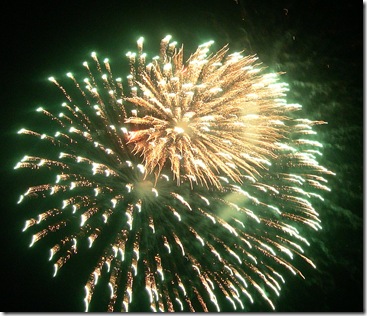On the Friday before the Victoria Day holiday in 1945, my dad splurged and spent three dollars on firecrackers at a store on Oakwood Avenue. Among his purchases were Pinwheels, Comets, Whiz-bangs, Fountains, Sparklers, and a Burning Schoolhouse. However, our favourites were the Roman Candles, as we knew that they rocketed high into the night sky, exploding in bursts of sparkling colour while creating loud crackling sounds.
On the 24th, as the sun commenced dipping slowly toward the western horizon, our anticipation increased. We gathered on the veranda, and anxiously waited for night skies to blanket the city. There were a few public displays in the parks, but none within easy travelling distance of our home. As a result, the families in our neighbourhood purchased their own fireworks, usually at a corner store that sold penny candy.
As it darkened further, we lit “whiz-bangs,” also referred to as “squibs,” which were small firecrackers, and tossed them into the street, where they exploded like gunshots. We waved sparklers in the air forming patterns of light. Finally, when it was totally dark, my dad set-off the serious firecrackers. Showers of flames burst from the curbs beside the sidewalk and rocket flares exploded, the scene reminiscent of a battlefield. My brother and I cheered as the Burning Schoolhouse was demolished in flames.
Neighbours staggered their displays so that not everyone’s exploded at the same time. All up and down Lauder Avenue, for over an hour, the night sky was broken with bursts of light. When our family had exhausted our supply, we watched the neighbours’ contributions. Adults supervised carefully, to prevent a mishap.
My brother and I were entranced by the fireworks, but my brother loved them the most. Even as an adult, he travelled considerable distances throughout the city to observe displays. On the night of May 24, 1945, I sat beside him and shared the excitement. After we were sent upstairs to bed, we crept into my parents’ bedroom and gazed out the window overlooking the street to observe the last of the explosions. A few teenagers had acquired their own firecrackers and were setting them off after the families with young children had retired from the scene. The next day, in the curbs beside the sidewalks, my brother and I observed the charred remains of the previous night’s revelries.
Similar to “the next-day” pumpkins and discarded Christmas trees, they were reminders of a glorious time well spent.
The History of Canada’s Spring holiday – Victoria Day
Queen Victoria, born 24 May 1819, ascended the British throne in 1837, at eighteen years of age, on the death of her uncle, King William 1V. The legislature of Canada West, the province later renamed Ontario, established the monarch’s birthday as a holiday in 1845, naming it Empire Day. This was an act of true homage to the queen, as in 1845 Christmas Day was not a legal holiday for workers. It was solely at the discretion of the employer.
The holiday was observed on the day in which it occurred, but if May 24th were on a Saturday or Sunday, the holiday was celebrated on the following Monday. In 1867, when four Canadian provinces joined to create the Dominion of Canada, they continued to celebrate the holiday in Ontario. In 1876, Victoria was crowned Empress of India, which engendered further prestige for the monarch.
When Victoria died in 1901, after reigning sixty-four years, the Parliament of Canada established the 24th as a national holiday, and changed its name to Victoria Day. In 1952, the government decided that the Victoria Day holiday would occur each year on the Monday prior to 25 May, and this has remained to the present era.
To view the Home Page for this blog: https://tayloronhistory.com/
For more information about the topics explored on this blog:
https://tayloronhistory.com/2016/03/02/tayloronhistory-comcheck-it-out/
The publication entitled, “Toronto’s Theatres and the Golden Age of the Silver Screen,” was written by the author of this blog. It explores 50 of Toronto’s old theatres and contains over 80 archival photographs of the facades, marquees and interiors of the theatres. It relates anecdotes and stories by the author and others who experienced these grand old movie houses.
To place an order for this book:
Book also available in Chapter/Indigo, the Bell Lightbox Book Shop, and by phoning University of Toronto Press, Distribution: 416-667-7791 (ISBN 978.1.62619.450.2)
Another book, published by Dundurn Press, containing 80 of Toronto’s former movie theatres will be released in June, 2016. It is entitled, “Toronto’s Movie Theatres of Yesteryear—Brought Back to Thrill You Again.” It contains over 125 archival photographs and relates interesting anecdotes about these grand old theatres and their fascinating histories.
Another publication, “Toronto Then and Now,” published by Pavilion Press (London, England) explores 75 of the city’s heritage sites. This book will be released in June 2016. For further information follow the link to Amazon.com here or contact the publisher directly by the link shown below:
http://www.ipgbook.com/toronto–then-and-now—products-9781910904077.php?page_id=21.

![cid_E474E4F9-11FC-42C9-AAAD-1B66D852[2] cid_E474E4F9-11FC-42C9-AAAD-1B66D852[2]](https://tayloronhistory.com/wp-content/uploads/2016/05/cid_e474e4f9-11fc-42c9-aaad-1b66d8522_thumb2.jpg)
![image_thumb6_thumb_thumb_thumb_thumb[2] image_thumb6_thumb_thumb_thumb_thumb[2]](https://tayloronhistory.com/wp-content/uploads/2016/05/image_thumb6_thumb_thumb_thumb_thumb2_thumb1.png)
